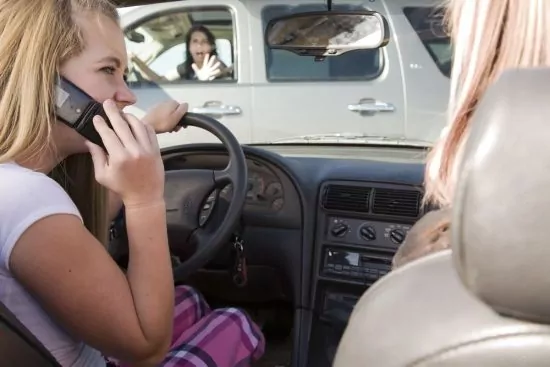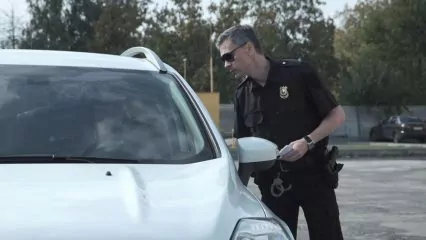Texting and driving accidents have become so commonplace these days that it is like an epidemic. As lawmakers across the country struggle to institute measures to prevent people from texting while driving, the death toll continues to count higher and higher. At best, texting and driving accident statistics present cause for concern, but at worst, they are downright terrifying. Here’s what you need to know about one of the worst driving hazards plaguing our country.
The Rise of Smartphones

In the past, hardly anyone had mobile phones. If you needed to talk to someone, you would have had to wait until you arrived at your destination where you could make a call from a landline phone. Nowadays, the vast majority of people have mobile phones, many of them being smartphones, meaning those with internet connectivity. Even for those that don’t have online access, it is still possible to send and receive text messages while on the go.
While text meassaging is great for staying in touch with friends and family, it is a distraction that many drivers find difficult to ignore, even if they are only driving for a few minutes. Rather than pulling over to the side of the road or into a parking lot to check a message, drivers foolishly believe that they can check the message quickly while still paying attention to the road. Although you may get lucky once, twice or even hundreds of times and not get into an accident, it is only a matter of time before your luck runs out.
The Problem with Texting While Driving
One of the first things you learn as a new driver is that you should always keep both hands on the wheel, aside from shifting gears. With most cars these days having automatic transmissions, keeping your hands on the wheel should not be difficult to do. In order to read a text message, you’ll have to pick up your phone, forcing you to take at least one hand off the wheel. Driving with only one hand on the wheel gives you less control over your vehicle, even if it is only for a few seconds.
Another primary lesson for new drivers is to always keep your eyes on the road. However, you can’t look at the road and your phone at the same time. While you may think that holding your phone up above the steering wheel will eliminate the problem, as you are able to still keep your eyes looking forward, the fact of the matter is that it is plain impossible to focus your eyes on two different things at once. Every second you spend looking at your phone is a second that you are not watching what is going on in front of you.
On average, it takes a person about five seconds to read a text message. At freeway speeds of 55 miles per hour or more, you’ll travel farther than the length of a football field without looking at the road. When you take into consideration the number of other drivers on the road, a lot can go wrong in even this short amount of time. It only takes a few seconds for an accident to occur, and those precious seconds you spent looking at your phone could have made the difference between getting in a crash and being able to avoid the accident.

It isn’t just texting that poses a risk, though; if you are using your phone as a navigation system, this can take your eyes off the road for even longer than texting does. It is far better to familiarize yourself with your route before you leave than to have to check directions while driving. Taking a few extra minutes before you leave could make the difference between you making it to your destination safely and getting into an accident on the way.
Cell Phone Usage Among Teens
The majority of adults and teens in the United States own cell phones and use them regularly, so it is not surprising that many of them continue to use their phones while driving. Teens are among the most at-risk drivers due to their lack of experience behind the wheel. In fact, teens are four times as likely to get into an accident when texting while driving as adults are.
While nearly all teens report that they are aware of the risks of texting while driving, a whopping 35 percent of them admit to doing it anyway. When it comes to talking on the phone while driving, the numbers are even higher. Of those who own cell phones, more than half of teens admitted to making or receiving calls while driving. As many as 20 percent admit to having entire conversations over text message while driving. At about five seconds for each message, that is a lot of time spent not looking at the road.
A common mistake many teenagers make is believing that they are capable of handling both tasks at the same time. Because they are so innately familiar with their mobile devices, they overestimate their ability to focus on the road while also sending or receiving a message. In fact, a teen’s reaction time to changes on the road while using a mobile phone is about the same as that of an elderly driver.
Unfortunately, the statistics don’t sugarcoat the gravity of this problem. Car accidents are the number one killer of teens in the United States. Each and every day, an average of 11 teenagers die due to texting while driving. This adds up to more than 4,000 teens each year who have their lives cut short. Had they not been texting, many of those teens would likely still be alive today. It is truly amazing how many lives could be saved by the simple act of waiting just a few extra minutes to read a text message.
Cell Phone Usage Among Adults
Of course, it is not just teens who text while driving; adults are guilty of this dangerous behavior as well. Like teens, many adults believe that they are capable of multi-tasking. As many as 77 percent of adults believe that they are up to the task. This is especially worrisome because most teens learn to drive from their parents. When they see their parents texting while driving, it reinforces that this behavior is considered to be acceptable, increasing the likelihood that the teens will text while driving when they get behind the wheel themselves.
Regardless of who is behind the wheel, the DMV estimates that more than 26 percent of all traffic accidents occur as a result of cell phone use while driving. This means that nearly a quarter of all traffic accidents could be avoided if drivers put down their phones and paid attention to the road in front of them.
If you still aren’t sold on the dangers of texting while driving, take into consideration that texting while driving increases your risk of getting into an accident to six times the level it would be if you were drunk. Most people know that they should not get behind the wheel after drinking, so it is astounding to think that they are willing to engage in a behavior that is six times as dangerous.

Common Excuses for Texting While Driving
Despite all of the risks involved, there are still so many people who continue to text while driving. When asked why they still do something so risky, people have a wide range of excuses, though they typically fall into a few common categories:
- Urgency— The most common reason people give for texting while driving is that the message was too important to be ignored. While there may be a select few instances when this would hold true, the vast majority of text messages are not matters of life and death, meaning that they can wait until you arrive at your destination. After all, even a message of the utmost urgency won’t get a response from you if you are killed in an accident while trying to read it. It is far better to wait until you can read the text safely than to put your life at risk.
- Specific Scenarios— Many drivers justify their behavior by only texting when they are stopped at red lights. However, it takes your brain a few seconds to transition between tasks. Even if you put the phone down again when the light turns green, your brain may not be focused enough on your surroundings to notice that a vehicle coming from the side is about to run a red light and slam into you as you enter the junction.
- Past Experience— This is one of the worst traps to fall into. Many people believe that their past success with texting while driving indicates their future success as well. The truth is that those drivers just happened to get lucky enough not to get into a crash while texting. Just because it hasn’t happened before does not mean that it won’t happen in the future. This false sense of security can lead people to text while driving even more frequently, compounding the risk even further.
With all of the statistics showing how dangerous texting and driving is, there is literally no valid excuse for doing it. There is nothing that can’t wait a few minutes when your life is at stake.
Legal Ramifications of Texting While Driving

Although the federal government in the United States hasn’t gotten involved in this issue just yet, the majority of states across the country have instituted their own laws to stop people from texting while behind the wheel. Nearly all of them expressly forbid texting while driving.
Many states have included restrictions against talking on the phone as well. There is a bit of wiggle room in this area, allowing drivers to use headsets and other hands-free devices for making calls. However, even talking to someone on the phone distracts you from driving, which is nearly as dangerous as taking your eyes off the road. When you are in the middle of a conversation, you may be aware of what is going on directly in front of you, but when you are driving, you need 360-degree awareness. This requires your full focus, and that just isn’t possible when you are talking on the phone.
In most jurisdictions, the penalties for teenagers using their phones while driving are more severe than those for adults. In addition to the fines and increased insurance rates adults have to pay, teens may also have their license suspended or revoked as a result of texting while driving. Because teens are more at risk than adults of getting into accidents in the first place, these heavier restrictions aim to provide enough of a deterrent to stop teens from using their phones in the car.
Despite the laws in place to prevent people from texting and calling while driving, there are still so many people who ignore them. Police in many areas, especially major cities, are already stretched so thin that they just don’t have the manpower to really enforce these laws. The best thing you can do is to set a good example yourself so that your teens and younger children learn the importance of focusing on the road.
What to Do If You Are Hit by a Distracted Driver
Even if you don’t text while driving yourself, you can still be hit by another driver who isn’t as careful. If you have been in an accident as the result of another driver engaging in this dangerous behavior, an experienced texting and driving accident attorney can help you get the compensation you deserve to cover your injuries and damage to your vehicle.
At Krasney Law, we are well-versed in California’s laws regarding cell phone use while driving, and we can evaluate your case to determine whether or not you are eligible to file a claim against the other driver. We’ll advocate on your behalf to achieve the best possible resolution for you. Get in touch with us today to learn more about our legal services and how we can help you.

